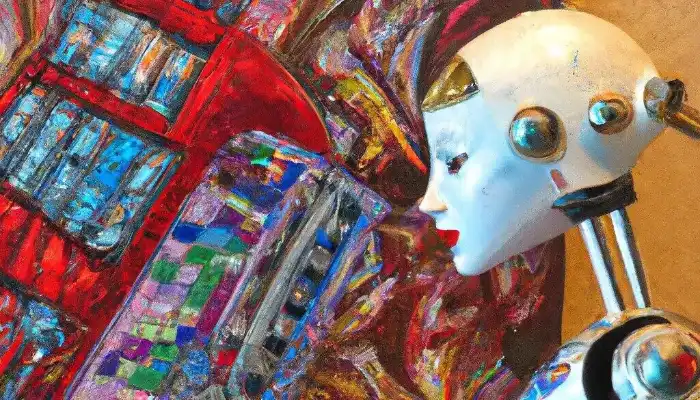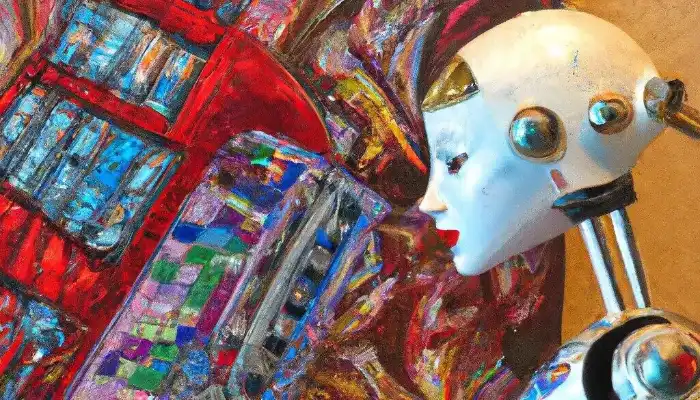The scope of artificial intelligence (AI) is continuing to expand, changing industries and redefining how we perceive what is happening in the world. This has made it difficult to distinguish between human intelligence and machine intelligence, as AI can now compose music and even write news articles that appear real. One such area of exploration that sparks curiosity is the intersection of AI and art: can machines create art or are they simply advanced tools capable of mimicking human creativity?

Defining Art and Creativity: A Complex Landscape
Before getting into AI-generated art, it is important to establish starting points with regards to art and creativity. Art, broadly speaking, can be defined as the expression of thoughts and imagination by humans through a variety of media ranging from painting, sculpture, music, or literature. On the contrary, creativity refers to coming up with new ideas or concepts. It is an intricate feature typical for humans, which includes things like envisioning solutions and being able to see outside the box.
Historically, the definition of art has been fluid and contentious. As civilization evolved from cave paintings to masterpieces of the Renaissance period, so did the concept of art changed. The appreciation for art often depends on subjective opinion, where cultural upbringing blends with personal experience to understand when something reaches artistic excellence.
Enter AI: A New Player in the Artistic Arena
AI has been a captivating presence in the world of fine arts more recently. Through methods such as deep learning, neural networks, and complex algorithms, among other techniques, AI can process huge amounts of data on artwork and generate some creative outputs like:
- Visual Art: From photorealistic landscapes to abstract paintings, AI makes beautiful images come alive virtually. For instance, there are algorithms which could be trained on particular styles and, if used, would tell Van Gogh’s brushwork apart from Mondrian’s geometric patterns.
- Music: By following existing genres or straying into new sonic territories, AI algorithms are now capable of composing original music.
- Literature: AI can sometimes write poems, scripts, and short stories with remarkable coherence and narrative structure.
Nonetheless, the question remains as to whether AI is actually creating art or if it is merely copying and transforming given data.
The Debate Over Artistic Authenticity
The rise of AI art has provoked a heated debate on the issue of artistic authenticity. Some key points include:
- The Argument for AI Art: Supporters argue that there is true creativity in AI-generated art. While producing such works, the algorithms do not just copy existing ones but rather manipulate them by mixing different elements.
- The Role of Intentionality: Detractors assert that AI lacks the intentionality and emotional depth so characteristic of human expression in art. Often, art represents emotions, experiences, and worldviews held by the artist. Can a machine fully recreate these human traits?
- Human Input in AI Art: It’s important to acknowledge the involvement of humans in creating AI-generated art. For example, artists often prepare the data sets used for training an artificial intelligence algorithm, which then determines what style or direction should be taken by its output work. Furthermore, human artists might also refine or complete pieces created by artificial intelligence, thus making it difficult to determine ownership.
The Integration of AI: A Spectrum of Views
AI integration garners mixed opinions in the art community. Some artists, including code writers and digital artists, have adopted AI as a new artistic tool. For them, AI algorithms serve as instruments to produce new forms of expression that go beyond conventional art practices.
However, some critics argue that AI-generated artwork is void of emotional depth and the activeness inherent in human creation. They insist that genuine art emanates from a purely human experience that encapsulates personal struggle, societal change, and raw emotions.
Meanwhile, scholars see AI as a collaborator rather than competing with it. They predict that AI will support artists in different ways, such as by creating variations on their ideas or composing complicated musical pieces. Such collaborative strategies might be seen as the basis for a renaissance of artistic expression.
Democratization or Commercialization? The Double-Edged Sword of AI
The potential democratization of art by AI is undeniable. By using AI tools, anyone with basic knowledge can create such art as music or visuals. This would empower a new generation of artists who could not create traditional art because they lacked resources and technical expertise.
However, it is also feared that, through commercializing art, this technology may end up leading to commodification. When mass production becomes controlled by a computer program like artificial intelligence (AI), divergence in terms of unique creative expressions goes down the drain. Thus, one could find themselves focused on producing “designer art” aimed at meeting specific market segments, possibly stifling real artistic exploration.
Ethical Considerations: A Brush with Responsibility
The development and application of Artificial Intelligence (AI) within artistic realms raise several ethical concerns. Questions surrounding intellectual property rights over artworks generated by AI must be answered first. Should it belong to an artist who employed an AI technique they learned from programming, or to those who wrote the source code?
Moreover, there’s also serious concern about possible bias and offensive works produced by an AI system. Machine Learning algorithms are trained on existing datasets, which could reinforce societal biases. Therefore, to have AI-generated art that is sensitive and inclusive, training data needs active curation.
The Evolving Relationship Between AI and Art: A Collaborative Future
Looking into the future, the future of AI in art is becoming more collaborative. Humans will probably still steer creativity, while AI may be a powerful tool for exploration and execution at their disposal. Artists might look to use the technology as a way of experimenting with themes, experimenting with different styles, or even making complex musical compositions. In this sense, new types of art may emerge that blend human creativity with the unlimited possibilities offered by AI.
Fostering Dialogue and Critical Thinking
It is important to encourage discussion and critical thinking about the role of Artificial Intelligence (AI) in art as it continues to develop. The questions raised by AI-generated art must be answered collectively by art institutions, artists themselves, and the public at large. This ongoing discourse will shape the destiny of art as well as keep AI within its locus as a tool for artistic expression rather than an alternative to human creativity.
Conclusion
The effect of AI on art is a multifaceted palette. Some people think that it threatens human creativity, while others view it as an opportunity for an artistic revolution through collaboration. The real future of art lies somewhere within these views. To make sure that AI enhances rather than diminishes the art landscape, accepting it as a tool and promoting open conversation about its ethical aspects are crucial steps to be taken. The coming age of AI will lead to a lively tapestry in which humans and machines work together, providing new ways of expression.

